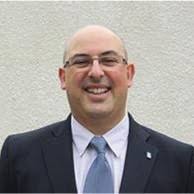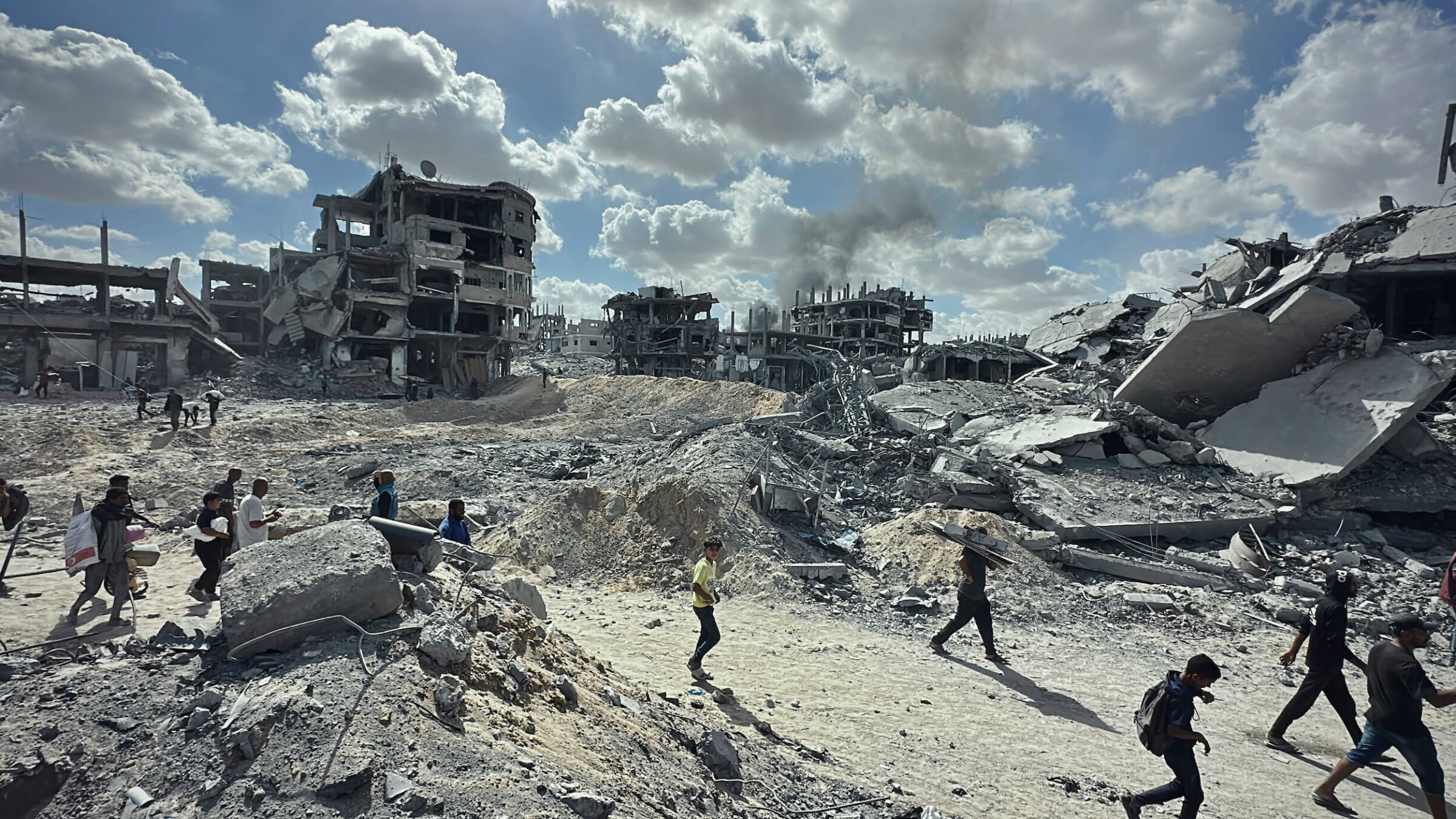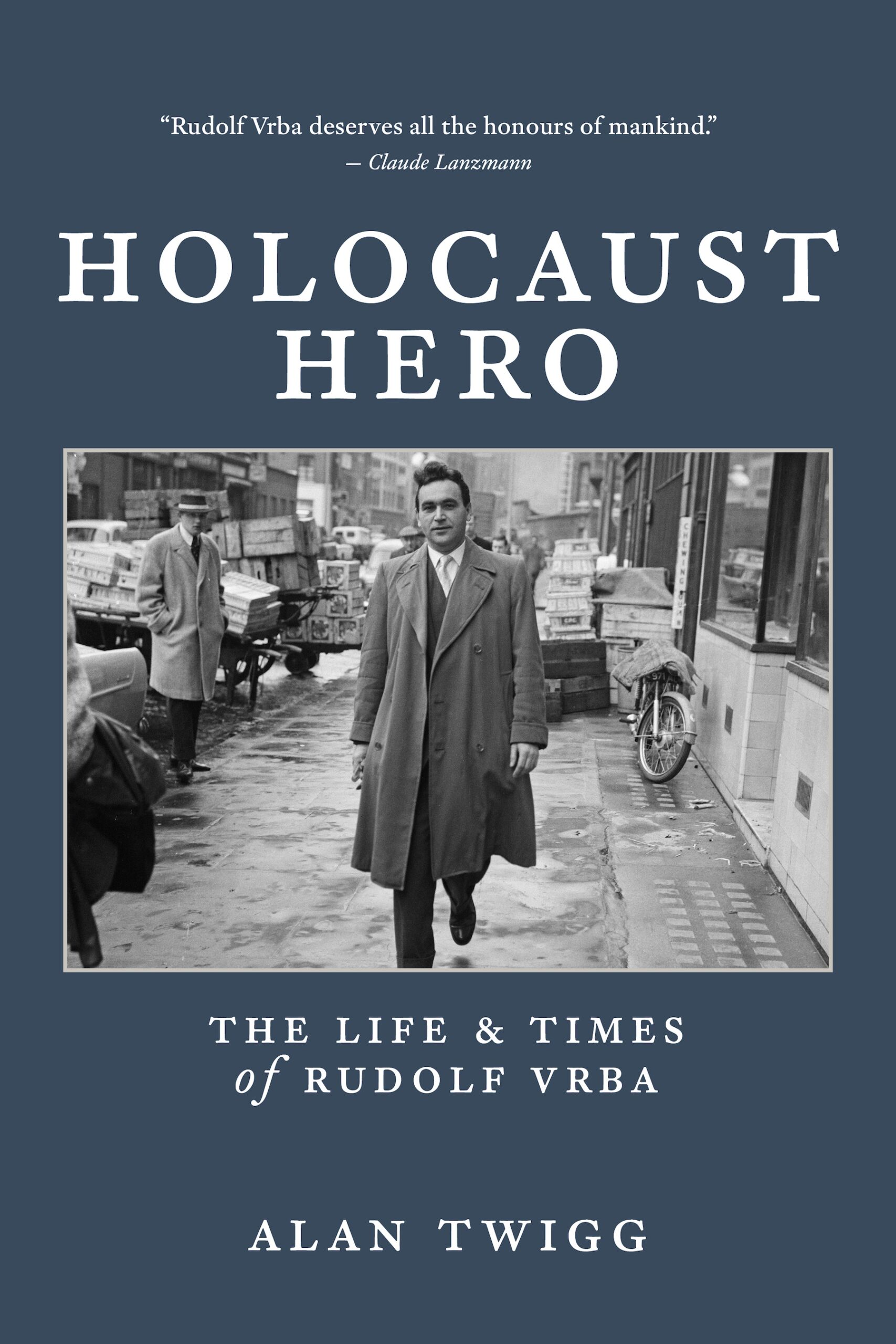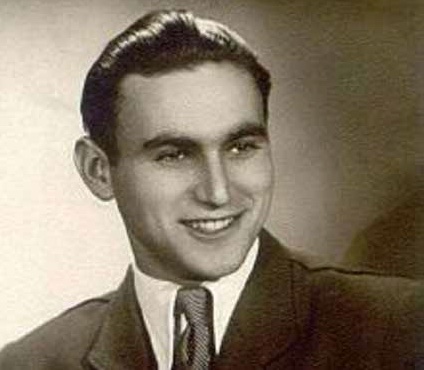Features
Haifa University launches $60 Million ‘Home Again’ Campaign to help rebuild war- devastated northern Israel

By MYRON LOVE In early July, Haifa University announced a new campaign to help rebuild the war-devastated communities of northern Israel. The “Home Again” campaign aims to raise $60 Million for regional recovery – and the Canadian Friends of Haifa University is set to do its part.
“We at CFHU hope to raise $1-million or more from our donors across Canada toward the campaign,” reports Ariel Karabelnicoff, executive director of Canadian Friends of Haifa University.
In an earlier interview that was published in this newspaper last year, the former Winnipegger – now in his third year with CFHU – noted that the University of Haifa is among the largest universities in Israel, but is also the youngest. Fully accredited in 1972, he said, the university has an enrollment of 18,000 students – with a student body that reflects the diversity of Israel’s population. About 40% of the students come from the Druze, Circassian and Arab communities and – among the Jewish students – there are many whose families are from Ethiopia.
The University of Haifa, Karabelnicoff added, also boasts the highest percentage among Israeli universities of students who are the first generation in their families to attend university.
The new initiative, he reports, aims to “restore and revitalize the north through science, innovation, and data-driven research rooted in community priorities and focused on real-world outcomes. “
While the campaign, Karabelnicoff points out, was originally conceived to address the cascading crises that first began on October 7, 2023, the urgency has become even greater due to direct missile strikes on Haifa and surrounding areas during the short war with Iran in April.
“The devastation brought mass displacement, overwhelmed public services, and deepened strain on communities already struggling to recover from months of conflict,” Karabelnicoff notes. “The campaign now represents not just regional recovery, but a cornerstone of Israel’s national resilience strategy for the post-conflict era. “
Karabelnicoff quotes University of Haifa President Professor Gur Alroey as stating that “in this moment of national crisis, when Israel’s northern communities have been tested like never before, University of Haifa is stepping forward to turn trauma into transformation. What was already a crucial mission of recovery after October 7 has become an existential imperative following the devastation of recent weeks. We are not just restoring what was lost, we are building the foundation for Israel’s long-term future—something stronger, more resilient, and more just.”
In the aftermath of October 7, Alroey reports, Hezbollah rockets devastated northern towns, triggering the largest internal displacement in Israel in decades. More than 68,000 people—families, farmers, and seniors—became refugees in their own country. Today, less than half have returned home. As Iranian long-range missiles threatened the north, communities faced not just a security crisis but a comprehensive breakdown in public health, education, employment, and social cohesion. In rural and peripheral areas, rehabilitation beds are scarce, mental health services are overwhelmed, and economic life has ground to a halt.
Karabelnicoff notes that the Home Again campaign is offering a coordinated, data-informed strategy, anchored in real-time research, local partnerships, and measurable programs across three core pillars.
The first is a multi-front recovery strategy – led by emotional and physical rehabilitation specialists affiliated with the university – for one of the region’s greatest invisible burdens – trauma.
“PTSD has surged by 33% among residents,” Karabelnicoff reports, “with children and parents bearing some of the deepest scars.”
Simultaneously, he continues, northern hospitals are ill-equipped to meet rising demands for complex rehabilitation care. The university is addressing both gaps.
The university is addressing this issue through mental health teams operating rapid-response networks – including the establishment of 24/7 hotlines and mobile therapeutic units. As well, the university’s Cheryl Spencer Nursing School is training more frontline responders to assess and manage trauma – and a proposed Community Rehabilitation and Research Center, spearheaded by Dr. Hilla Sarig Bahat, would merge academic research with hands-on clinical care—the first model of its kind in Israel.
The second focus is aimed at restoring economic stability and regional capacity in the north. With unemployment in the north spiking nearly 50%, Karabelnicoff points out, “the university is launching targeted workforce initiatives designed to meet immediate needs and build long-term regional capacity. These include specialized training programs for nurses, educators, trauma specialists, and environmental rehabilitation professionals. Additionally, discharged soldiers are being offered re-skilling opportunities in sustainable marine industries tied to Israel’s northern coastline, connecting economic recovery to national resilience.”
The final prong in the University of Haifa’s new initiative is focused on investing in community futures through real-time legal aid clinics, AI-assisted social service platforms, and coexistence-building programs that will bring Jewish and Arab residents together in the workplace.
“The university is working to restore both public trust and strategic cohesion,” Karabelnicoff says. “Researchers are partnering with kibbutzim, regional councils, and national ministries to revitalize schools, renew cultural life, and strengthen the social fabric at a time when national solidarity is dangerously frayed.”
For readers interested in contacting Ariel about supporting this new Canadian Friends of Haifa University initiative, his email address is ariel.karabelnicoff@haifa-univ.ca.
Features
I know exactly why leftists aren’t celebrating this ceasefire

Relief that the fighting may be at an end is one thing. Joy — after all this suffering — is another
This story was originally published in the Forward. Click here to get the Forward’s free email newsletters delivered to your inbox.
“We can’t hear you, Zohran,” read one New York Post headline this week: “Pro-Hamas crowd goes quiet on Trump’s Gaza peace deal.”
“It seems awfully curious that the people who have made Gazans a central political cause do not seem at all relieved that there’s at least a temporary cessation of violence … Why aren’t there widespread celebrations across Western cities and college campuses today?” the article asked.
The Post wasn’t alone in voicing that question. A spokesperson for the Republican Jewish Coalition posted on X that “The silence from the ‘ceasefire now’ crowd is shameful and deafening.” Others went so far as to imply that the protesters had been lying and never actually wanted a ceasefire — because what they really wanted wasn’t freedom and security for Palestinians, but the ability to blame Israel. If pro-Palestinian voices had really wanted a ceasefire, the thinking went, they would be celebrating.
I read these various posts and articles and thought of Rania Abu Anza.
I have thought of her every day since I first read her story in early March 2024. Anza spent a decade trying to have a child through in vitro fertilization. When her twins, a boy and a girl, were five months old, an Israeli strike killed them. It also killed her husband and 11 other members of her family.
A year and a half later, a ceasefire cannot bring her children, her husband, or her 11 family members back. They were killed. They will stay dead. What is there to celebrate?
This does not mean that the ceasefire is not welcome, or that it is not a relief. On the contrary: It is both. Of course it’s a relief that the families of hostages don’t need to live one more day in torment and anguish. Of course it’s a relief that more bombs will not fall on Gaza.
But celebration implies, to me anyway, that this is a positive without caveats. And in this situation, there are so many caveats.
The families of the surviving hostages will still have spent years apart from their loved ones, in no small part because their own government did not treat the hostages’ return as the single highest priority. The families of those hostages who were killed in the war will never again sit down to dinner with their loved ones, who could have been saved. And it is difficult to fathom what’s been taken from the hostages themselves: time spent out exploring the world, or with family and friends, or at home doing nothing much at all but sitting safely in quiet contemplation.
And a ceasefire alone will not heal Israeli society, or return trust to the people in their government. It will not fix some of the deep societal problems this war uncovered. A Chatham House report this August found that: “Israeli television ignores the suffering of Palestinians in Gaza, while the rhetoric is often aggressive. Critical voices, from inside Israel or abroad, are attacked or silenced.” If the country is ever going to find its way back from Oct. 7 and this war, a ceasefire is a necessary precondition, but not a route in and of itself.
In Gaza, Palestinian health authorities have said that about 67,000 people — not distinguishing between combatants and civilians — have been killed by Israel’s campaign in response to Oct. 7. A full third of those killed were under the age of 18. The ceasefire cannot bring those children back to life.
It cannot turn back time and make it such that Israel admitted more than minimal aid to the embattled strip. It will not undo the damage that has been done to the people of Gaza who were denied enough to eat and drink and proper medical care. It will not give children back their parents, or parents back their children. It will not heal the disabled, or make it so that they were never wounded.
It will not change that all of this happened with the backing of the United States government. (This is to say nothing of the West Bank, which has seen a dramatic expansion of Israeli settlements and escalation of settler violence over the course of the war). And as American Jewish groups put out statements cheering the ceasefire, we should also remember that it does not reverse the reality that too many American Jews were cheerleaders for all this death.
Protesters calling for a ceasefire have regularly been denounced as hateful toward Jews or callous toward the plight of Israelis; American Jews who called for one were called somehow un-Jewish. (Yes, some pro-Palestinian protesters also shared hate toward Jews; the much greater majority did not.) The charge of antisemitism — toward those calling for a ceasefire, those calling for a free Palestine, and those who called attention to Israel’s abuses during this war — was used to silence criticism of Israel and of U.S. foreign policy. Some American Jews went so far as to call for the deportation of students protesting the war.
A ceasefire doesn’t change any of that. It can’t.
I have hopes for this ceasefire. At best, it will allow people — Israelis and Palestinians and, yes, diaspora Jews — to chart a new, better course going forward. But it almost certainly will not do that if we delude ourselves into thinking of this as a victory or a kind of tabula rasa, as though the lives lost and hate spewed are all behind us, forgotten, atoned for. The last two years will never not have happened. What happens next depends on all of us fully appreciating that.
This story was originally published on the Forward.
Features
New book about a man who helped to save the lives of 200,000 Hungarian Jews

Reviewed by BERNIE BELLAN I have to admit that, as much as I consider myself reasonably informed about the history of the Holocaust, I had never heard of Rudolf Vrba.
Further, when it comes to an understanding of what happened to Hungary’s Jewish population, it’s the story of Swedish diplomat Raoul Wallenberg that comes foremost to mind.
But now, after having read a new book by Canadian journalist Alan Twigg, titled “Holocaust Hero – The Life & Times of Rudolf Vrba,” I have a much better understanding of what happened to Hungarian Jewry.
There were approximately 800,000 Jews alive in Hungary at the beginning of World War II and, even though 63,000 Hungarian Jews had been murdered by their fellow Hungarians prior to Germany’s entry into Hungary in March 1944 (with the willing cooperation of Hungarian authorities), by the end of World War II only about 200,000 Hungarian Jews remained alive. Of the Jews who were murdered by the Nazis, 424,000 were sent to their deaths in Auschwitz-Birkenau – in a relatively short period of time: between April and July, 1944.
There would have been many more Hungarian Jews who would have been sent to Auschwitz-Birkenau, however, were it not for the heroism of two individuals who actually managed to escape from Auschwitz in April 1944: Rudolf Vrba and Alfred Wetzler.
While there have been many books written describing how those two brave men managed to escape Auschwitz (and there were only six individuals who managed to do that the entire time Auschwitz was in existence as the largest death camp in the history of the world), Rudolf Vrba’s story is one that should be of particular interest to Canadians because Vrba actually lived in Canada for 31 years of this life, when he was a very well respected professor of biochemistry at the University of British Columbia.
Now, with a recently released book by a well known Canadian historian and journalist by the name of Alan Twigg, a much more complete account of Vrba’s story, beginning with his childhood in Slovakia and ending with a long interview with Vrba’s second wife, Robin Vrba, is available.

Here are the first two paragraphs taken from Twigg’s introduction to the book, which describe in a nutshell why Vrba deserves to be celebrated: “This first volume of a two-volume biography asserts there was much more to Rudolf Vrba than his escape from Auschwitz and his subsequent report that saved 200,000 lives. An outstanding medical researcher, Vrba submitted testimony at the Eichmann trial, pursued war criminals, served globally as a riveting public speaker and combatted Holocaust denialists.
“Under his birth name Walter Rosenberg, he survived…24 near-death experiences over a three-year period as a teenager… At 20, he fought in ten life-threatening battles as a Partisan in the mountains of Slovakia and became a decorated war hero. Rudolf Vrba was a Jew who fought back.”
Twigg explains that this book deals mostly with Vrba’s life up to 1946 and that a second volume will explore his quite successful career as a biochemist.
What emerges though, from Twigg’s account of Vrba’s life is unbridled admiration for Vrba’s brilliance – as someone who could make instant assessments of life or death situations and, no matter how fraught with danger the wrong choice could entail, retained his composure and thought his way through to survival.
Born Walter Rosenberg, Vrba was eventually given the alias Rudolf Vrba by Jewish authorities in Slovakia, which is to where he escaped from Auschwitz with Wetzler in April 1944. Rather than reverting to Walter Rosenberg following the war he kept the name Rudolf Vrba.
Twigg provides a great deal of information about Vrba’s early life throughout the book, but what is sure to grab the reader’s attention and want to make even someone who might not be all that interested in reading something about a Holocaust survivor is the introduction in which Twigg lists the 24 different experiences that Vrba survived as a teenager, each of which – had they gone the wrong way, could very well have ended with his death.
The fact that Vrba was one of only six Jews to have escaped Auschwitz is amazing in itself, but it is what he – along with Wetzler, did after escaping that makes one wonder why he hasn’t received greater recognition in Canada – and which leads Twigg to want to correct that grave injustice.
Vrba and Wetzler wrote down what they had witnessed happening in Auschwitz-Birkenau in a 20-page report that was given to Slovakian Jewish authorities and which became known as the “Vrba-Wetzler Report.” It provided detailed information about the large scale extermination of what the report calculated were 1,765,000 Jews between April 1942 and April 1944, all of whom had been murdered in Auschwitz-Birkenau.
Vrba had an incredible memory for detail and it was the figures that he entered into the report that came to be accepted as quite accurate when they were later corroborated by the testimony of others, including the most notorious commandant of Auschwitz, Rudolf Hoss (or Hoess).
Although Vrba only arrived in Auschwitz in June 1942, he based his calculations on what he saw transpiring every day that he was there, when he witnessed the number of trains arriving daily, how many boxcars were part of each train (45 on average), and how many people were stuffed into each boxcar (60 on average).
While the report did receive dissemination among various Western European and American authorities, Twigg argues that it was deliberately suppressed by leaders of the Hungarian Jewish community – who had been well aware of the report around the same time mass deportations of Hungarian Jews began in April 1944. Germany had not entered into Hungary until March 1944 and the Hungarian Jewish community was the last Jewish community to be largely extinguished during the war.
A major part of Twigg’s book deals with Vrba’s contention that one man in particular, Rudolf Kastner, who was head of what was known as the Budapest Aid and Rescue Committee, and who was well aware of the Vrba-Wetzler Report, could have used his influence to warn Hungarian Jews about their impending fate at the hands of the Nazis but, for whatever reasons he may have had, chose not to do so. (Twigg does describe though, a deal Kastner made with Adolph Eichmann, who was in charge of Germany’s extermination program in Hungary, to save the lives of 1600 Hungarian Jews, many of whom were either friends or relatives of Kastner.) The contempt with which Vrba and, in turn, Twigg, held for Kastner and those who came to his defense – including one of Israel’s most respected historians, Yehuda Bauer, emerges clearly in the book.
Eventually, however, and in no small part, due to the failure of leaders of Hungary’s Jewish community to warn their fellow Jews what fate awaited them if they followed orders to board the trains, over 400,000 Hungarian Jews were sent to their slaughter. With the total cooperation of Hungarian authorities, Jews – as they were in every other jurisdiction where they were ordered on to trains, were misled into thinking that they were simply being deported, not headed for extermination.
It was only after the Vrba-Wetzler Report gained wide dissemination, a process which Twigg describes in some detail, that pressure began to mount on Miklos Horthy, the “Regent” of Hungary, to stop assisting the Germans in the deportation of Hungarian Jews. (After reading other information about Horthy, however, it is not clear the extent to which Horthy was aware Jews were being sent to their deaths prior to the publication of the Vrba-Wetzler Report. Twigg does not enter into that debate.)
While “Holocaust Hero – The Life & Times of Rudolf Vrba” does tell a fascinating story, at times it does lose momentum. Perhaps because Twigg makes quite clear from the outset that he is a journalist and a historian, not a novelist, he relies upon previously written accounts, including Vrba’s own autobiography, to cobble together a narrative from a variety of different sources. What results is a book that will probably be of great interest to students of history, but not as much to those who might prefer to read a story laden with graphic imagery.
There are many instances throughout the book where Twigg takes great pains to offer substantiation for what he says happened to Vrba during the Second World War – which was undoubtedly horrifying, but because the author is so dispassionate in his writing, what Vrba endured does not come across as chillingly as one might expect.
Reading about stacking bodies in advance of their being taken to a crematorium or of sorting through the possessions of the victims – all of which Vrba did, doesn’t quite deliver the gut punch that we’ve come to expect when we see actual visual representations of the same experiences – whether it be through documentary footage or dramatizations in such films as “Schindler’s List” or , to my mind, the most riveting film ever made about what life in Auschwitz was truly like – “Son of Saul,” a Hungarian film that won the Academy Award for best foreign film in 2015.
The book contains quite a bit more information than perhaps the average reader might need to know, including a very lengthy transcript of an interview Twigg had with Vrba’s widow, Robin Vrba. While it’s somewhat interesting to read about their life together, it’s hardly germane to the story how important a role Vrba ultimately played in saving the lives of 200,000 Hungarian Jews.
Still, as we approach the anniversary of Kristallnacht, which happened 87 years ago, and which was the harbinger of what was to come for European Jewry, reading a book that describes how one individual in particular, Rudolf Vrba, not only survived the Holocaust when almost anyone else in the same situations he repeatedly encountered would have succumbed to the easy way out and accepted death, it reminds us that stories of heroism on an unimaginable level can make us realize that whatever hardships we may face in our own lives pale in comparison to what someone like Vrba endured.
“Holocaust Hero – The Life & Times of Rudolf Vrba”
By Alan Twigg
153 pages
Published by Firefly Books, September 2025
Features
Bitcoin Price Volatility: WOA Crypto – Why Cloud Mining Becomes a Safe Haven for Investors

(Posted Oct. 10, 2025) Bitcoin once again attracted market attention today, with the price around $122,259, with an intraday high of $124,138 and a low of $121,141. Driven by capital flows, ETF inflows, and macroeconomic factors, Bitcoin recently hit a new high, but encountered retracement pressure today and fluctuated widely between $121,000 and $124,000 during the initial decline.
There have been no major structural changes in capital flows. For most investors, the best way to deal with volatility is not to try to precisely time peaks and troughs, but to let assets generate returns both in the ups and downs.
Cloud Mining: A New Approach Beyond “Observing the Charts”
In a constantly volatile market, checking charts, chasing peaks (and then cutting losses) is routine—actions that often lead to emotional exhaustion and poor decision-making. Cloud mining offers a solid, rules-based revenue model.
What is cloud mining?
Cloud mining allows you to mine Bitcoin and other altcoins without having to purchase, manage, or maintain any mining hardware. Simply invest your digital assets (e.g., BTC, ETH, XRP, USDT), and the platform will provide you with the computing power and handle all technical issues. Yes, the system will mine for you and pay you daily.
To summarize: you invest cash, the platform provides computing power, and your time pays off.
During periods of high prices and volatility, cloud mining (due to its daily payouts and weak correlation with price fluctuations) attracts more rational investors.
WOA Crypto Mining: Making Cloud Mining Practical
Among the many cloud mining services, WOA Crypto positions itself as a simple, secure, and transparent service—allowing investors to focus on more than just price monitoring.
Key highlights of WOA Crypto
Zero technical barriers: No hardware setup or maintenance required.
Daily payouts: Profits are automatically settled every 24 hours, ensuring a stable cash flow.
Multi-asset support: Accepts BTC, ETH, XRP, and USDT.
Transparent and secure system: Clear rules, an open profit structure, and a proven withdrawal mechanism.
Green energy and global deployment: Using efficient computing centers powered by renewable energy to increase stability and reduce costs
How to start your WOA Crypto mining journey
Visit the official WOA Crypto website.
Register using your email address and create a password.
Simply deposit BTC, ETH, XRP, or USDT, and your funds will be converted into computing power.
Choose a mining contract plan and start earning your first profit within 24 hours.
No technical knowledge or hardware required, no need to follow market trends: this simple-to-use app will give you a comfortable home cloud mining experience. Click here to get started.
Conclusion: Finding stability amidst volatility
While the price of Bitcoin has fluctuated between $121,000 and $124,000, the winners haven’t been those who perfectly timed the tops and bottoms, but rather those who consistently let the asset perform.
Cloud mining eliminates most of the emotional fluctuations in trading and provides a strategy that is easy to accumulate over the long term, which can continue to accumulate capital even in uncertain times. In times of market volatility, letting assets grow in value is undoubtedly the most resilient investment strategy.
Official email: info@woacrypto.com


